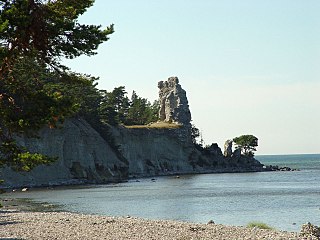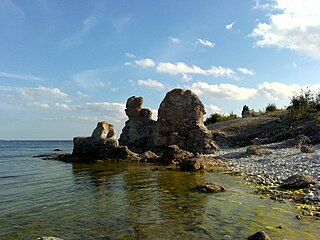
Gotland, also historically spelled Gottland or Gothland, is Sweden's largest island. It is also a province/county, municipality, and diocese. The province includes the islands of Fårö and Gotska Sandön to the north, as well as the Karlsö Islands to the west. The population is 61,001, of which about 23,600 live in Visby, the main town. Outside Visby, there are minor settlements and a mainly rural population. The island of Gotland and the other areas of the province of Gotland make up less than one percent of Sweden's total land area. The county formed by the archipelago is the second smallest by area and is the least populated in Sweden. In spite of the small size due to its narrow width, the driving distance between the furthermost points of the populated islands is about 170 kilometres (110 mi).

Fårö or Fåre in Gutnish is a Baltic Sea island just north of the island of Gotland, itself off mainland Sweden's southeastern coast. It is the second-largest island in the county and it is a popular summer resort. It has its own language, Faroymal, a dialect of Gutnish.

Gotska Sandön is an uninhabited Swedish island north of Gotland in the Baltic Sea. It has been a national park since 1909.

A rauk is a column-like landform in Sweden, often equivalent to a stack. Rauks often occur in groups called raukfält 'rauk fields'. The limestone rauks of Gotland in the Baltic Sea are among the best known examples.

Hemse is a locality situated on the Swedish island of Gotland with 1,700 inhabitants in 2014. It is the second largest locality on the island. Hemse is the main center of population in the southern part of the island, and it is known for its markets.

Slite is a locality situated in Gotland Municipality, Gotland County, on the island of Gotland, Sweden with 1,500 inhabitants in 2014.

Lickershamn is a small settlement and fishing village situated in Stenkyrka on the Swedish island of Gotland.

Fleringe is a populated area, a socken, on the Swedish island of Gotland. It comprises the same area as the administrative Fleringe District, established on 1 January 2016.

Stenkyrka is a populated area, a socken, on the Swedish island of Gotland. It comprises the same area as the administrative Stenkyrka District, established on 1 January 2016.

Vamlingbo is a populated area, a socken, on the Swedish island of Gotland. It comprises the same area as the administrative Vamlingbo District, established on 1 January 2016.

Lake Tingstäde is a lake next to Tingstäde in the central northern part of Gotland, Sweden. It is the second biggest lake on Gotland, after Lake Bästeträsk. The surface of the lake is 44.1 m (145 ft) above sea level.

Näsudden is a peninsula on the south coast of Gotland, Sweden. The first tests for using wind power on a large scale in Sweden, were conducted there in the 1970s. The area has since been developed into a wind farm. Part of the peninsula is a nature reserve for birds and grey seals.

Hamra is a populated area, a socken, on the Swedish island of Gotland. It comprises the same area as the administrative Hamra District, established on 1 January 2016.

Sundre is a populated area, a socken, on the Swedish island of Gotland. It comprises the same area as the administrative Sundre District, established on 1 January 2016.

Fide is a populated area, a socken, on the Swedish island of Gotland. It comprises the same area as the administrative Fide District, established on 1 January 2016.

Öja is a populated area, a socken, on the Swedish island of Gotland. It comprises the same area as the administrative Öja District, established on 1 January 2016.

Östergarn is a populated area, a socken, on the Swedish island of Gotland. It comprises the same area as the administrative Östergarn District, established on 1 January 2016.

Gothem is a populated area, a socken, on the Swedish island of Gotland. It comprises the same area as the administrative Gothem District, established on 1 January 2016.

Västergarn is a populated area, a socken, on the Swedish island of Gotland. It comprises the same area as the administrative Västergarn District, established on 1 January 2016.

Hellvi is a populated area, a socken, on the Swedish island of Gotland. It comprises the same area as the administrative Hellvi District, established on 1 January 2016.





















